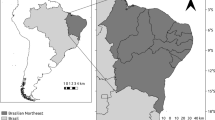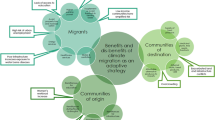Abstract
This article presents an initial attempt to investigate the issue of climate migration in Tunisia. Precipitation and temperature are used as climate-representative variables. Indeed, using a new analysis on spatial modeling, this work demonstrates the direct and indirect effects of precipitation as well as temperature on the climate migration of a governorate and those of neighboring governorates through the production of irrigated and non-irrigated plants. In addition, spatial modeling shows that the impact of climate change on migration through cereal and olive production differs from that of irrigated plants, thus demonstrating the importance of taking explicit account of the spatial effects between governorates. The decline in a farmer’s income in (a) governorate is a factor in rural exodus and migration to other governorates with water and a more favorable climate. This cause-and-effect phenomenon is known as negative externalities because some regions are forced to suffer from the consequences of the arrival of a new population. The originality of this method is that it allows the impact of spatial externalities to be taken into account in an effective way. The data used describe the 24 Tunisian governorates.




Similar content being viewed by others
References
Abu M, Codjoe SNA, Sward J (2013) Climate change and internal migration intentions in the forest-savannah transition zone of Ghana. Popul Environ 35(4):341–364
Anselin L (1995) Local indicators of spatial association-LISA. Geogr Anal 27(2):93–115
Anselin L (2001) Spatial Effects in Econometric Practice in Environmental and Resource Economics. Am J Agric Econ 83(3):705–710
Baltagi B, Liu L (2008) Testing for random effects and spatial lag dependence in panel data models. Stat Probab Lett 78(18):3304–3306
Barrios S, Bertinelli L, Strobl E (2006) Climatic change and rural – urban migration: the case of Sub-Saharan Africa. J Urban Econ 60:357–371
Beine M, Parsons C (2014) Climatic factors as determinants of international migration. Scand J Econ 117(2):723–767
Bohra-Mishra P, Oppenheimer M, Cai R, Feng S, Licker R (2016) Climate variability and migration in the Philippines. Popul Environ 38(3):286–308
Cattaneo C, Peri G (2016) The migration response to increasing temperatures. J Dev Econ 122:127–146
Cline WR (2007) Global warming and agriculture: impact estimates by country. Center for Global Development and Peterson Institute for International Economics, Washington, DC
Dubé J, Legros D (2014) Econométrie spatiale appliquée des microdonnées. ISTE editions
Elhorst JP (2010) Dynamic panels with endogenous interactions effects when T is small. Reg Sci Urban Econ 40:272–282
FAO (2017) "La Situation Mondiale de L’alimentation et de l’agriculture"
Feng S, Krueger AB, Oppenheimer M (2010) Linkages among climate change, crop yields and Mexico-US cross-border migration. Proc Natl Acad Sci 107(32):14257–14262
Foresight (2011) Migration and global environmental change final project report. In: London: from the Middle East and North Africa. Bank Study, Washington, DC, World
Giorgi F (2006) Climate change hot-spots. Geophys Res Lett 33(8)
GIZ (2012) Stratégie nationale sur le changement climatique
Glaser R, Himmelsbach I, Bösmeier A (2017) Climate of migration? How climate triggered migration from southwest Germany to North America during the 19th century. Clim Past 13(11):1573–1592
IPCC (2014) Intergovernmental panel on climate change: impacts, adaptation, and vulnerability, fifth assessment report (AR5)
James T, Arndt C, Farmer W, Strzepek K (2012) Climate change, agriculture and food security in Tanzania. Rev Dev Econ 16(3):378–393
Kubik Z, Maurel M (2016) Weather shocks, agricultural production and migration: evidence from Tanzania. J Dev Stud 52(5):665–680
Le Gallo J (2002) Econométrie spatiale: l'autocorrélation spatiale dans les modèles de régression linéaire. Economie & prévision 155(4):139–158.
LeSage JP, Pace KR (2009) Introduction to spatial econometrics. CRC Press/Taylor & Francis, Boca Raton
Lohano HD (2017) Weather variability, agricultural revenues and internal migration: evidence from Pakistan. Clim Dev:1–19
Mathilde M, Kubik Z (2014) Climate variability and migration: evidence from Tanzania, Working Papers P104. FERDI
Minale L (2018) Agricultural productivity shocks, labour reallocation and rural–urban migration in China. J Econ Geogr. https://doi.org/10.1093/jeg/lby013
Munshi K (2003) Networks in the modern economy: Mexican migrants in the U. S. Labor market. Q J Econ 118:549–599
Nguyen, Cong, Minh and Wodon, Quentin (2014): Extreme weather events and migration: the case of Morocco. https://mpra.ub.uni-muenchen.de/56938/
OIM (2018) Migration et changement climatique https://www.iom.int/fr/migration-et- changement-climatique, Novembre 2018
ONUA (2017): Migration et agriculture, http://www.fao.org/fao-stories/article/fr/c/1072961/ janvier 2019
Peri, Requena (2009) The trade creation effect of immigrants: testing the theory on the remarkable case of Spain. CReAM discussion paper series 1-37
Puente GB, Perez F, Gitter RJ (2016) The effect of rainfall on migration from Mexico to the United States. Int Migr Rev 50(4):890–909
Robinson S, Willenbockel D, Strzepek K (2012) A dynamic general equilibrium analysis of adaptation to climate change in Ethiopia. Rev Dev Econ 16(3):489–502
Rupasingha A, Goetz S (2007) Social and political forces as determinants of poverty: a spatial analysis. Journal of Socio-Economics 36(4):650–671
Whittle P (1954) On stationary processes in the plane. Biometrica 41:434–449
Wodon, Q., A. Liverani, G. Joseph and N. Bougnoux, (2014). Editors, climate change and migration: evidence from the Middle East and North Africa
World Bank (2018) Migration and remittances fact book 2011. The International Bank for Reconstruction and Development / The World Bank, Washington DC, USA, p 246
Zhai F, Tun L, Byambadorj E (2009) A general equilibrium analysis of the impact of climate change on agriculture in the People’s Republic of China. Asian Dev Rev 26(1):206–225
Zouabi O, Peridy N (2015) The impact of climate change on agriculture: an application of a spatial panel data analysis to Tunisia. Clim Chang 133(2):301–320
Author information
Authors and Affiliations
Corresponding author
Additional information
Publisher’s note
Springer Nature remains neutral with regard to jurisdictional claims in published maps and institutional affiliations.
Rights and permissions
About this article
Cite this article
Zouabi, O. Climate change and climate migration: issues and questions around an in-transition Tunisian economy. Climatic Change 164, 32 (2021). https://doi.org/10.1007/s10584-021-03006-2
Received:
Accepted:
Published:
DOI: https://doi.org/10.1007/s10584-021-03006-2





